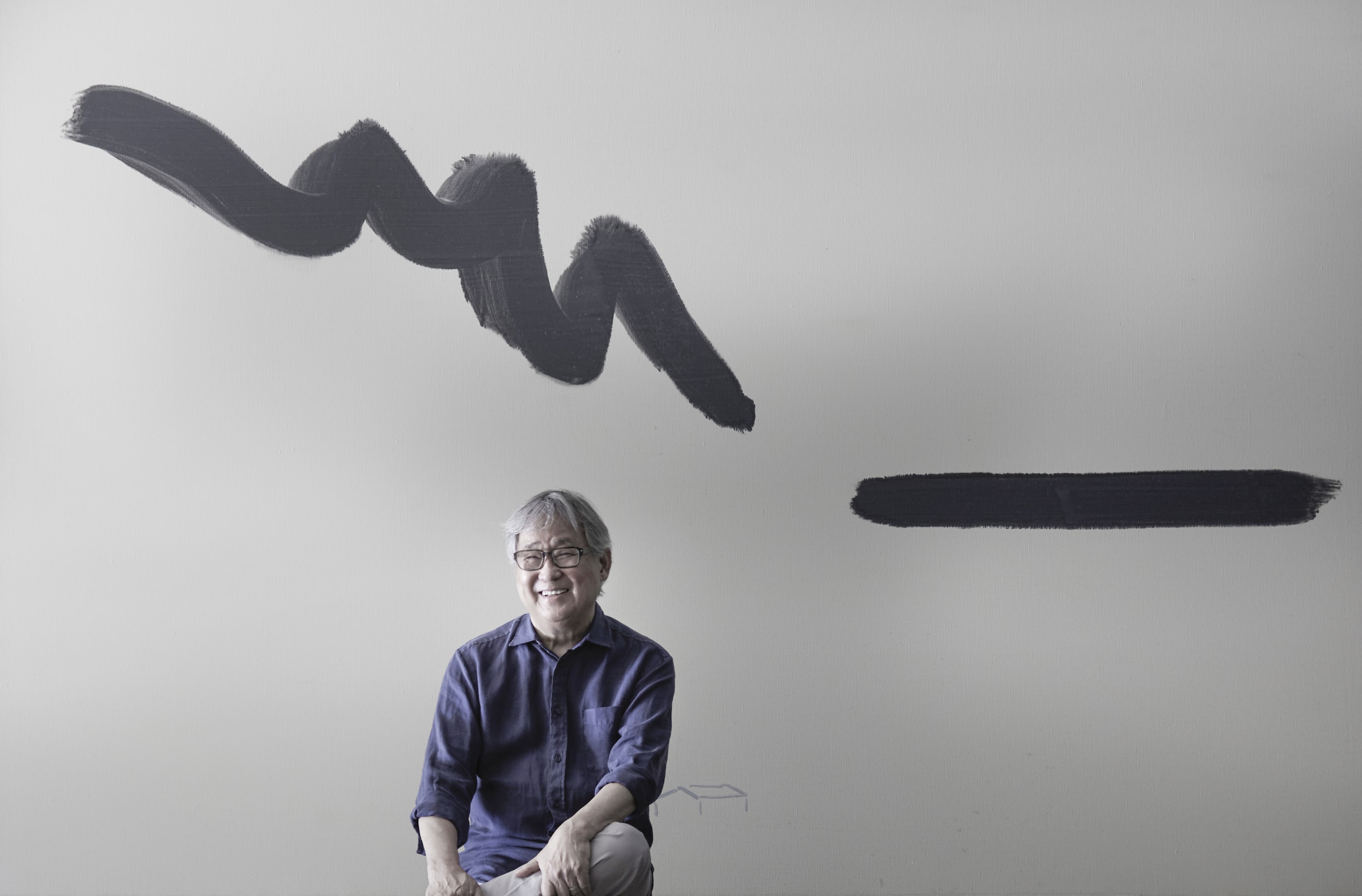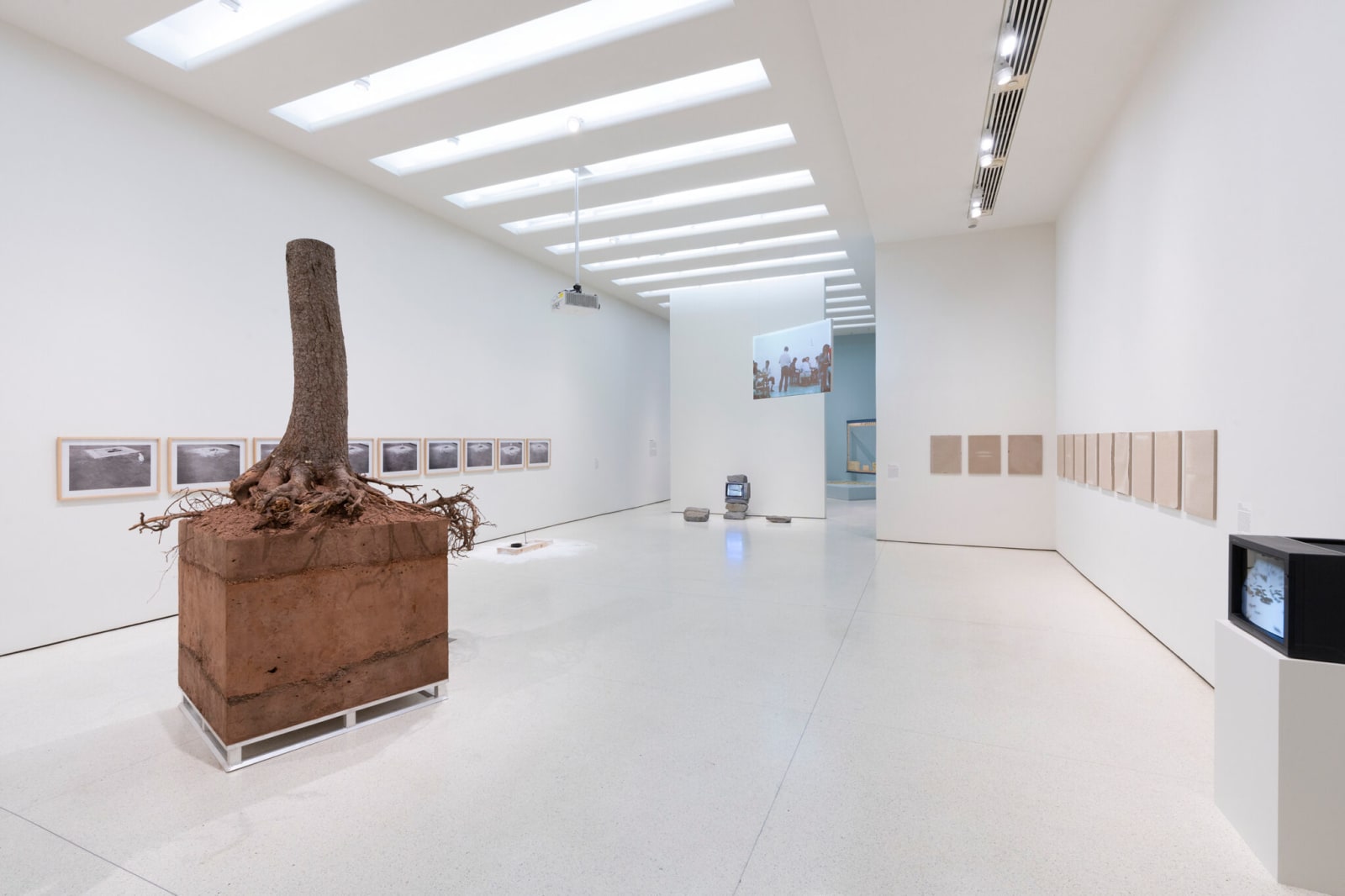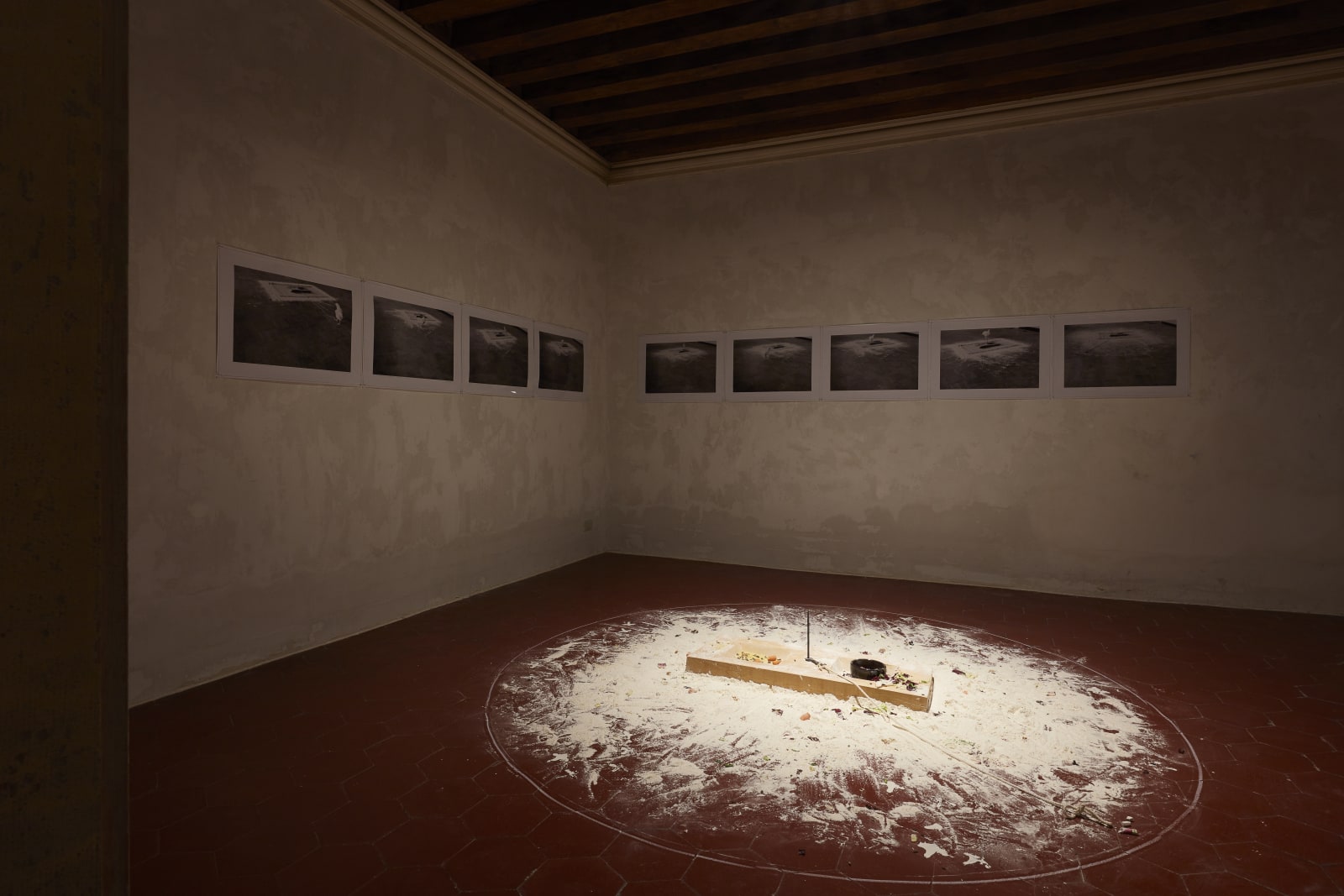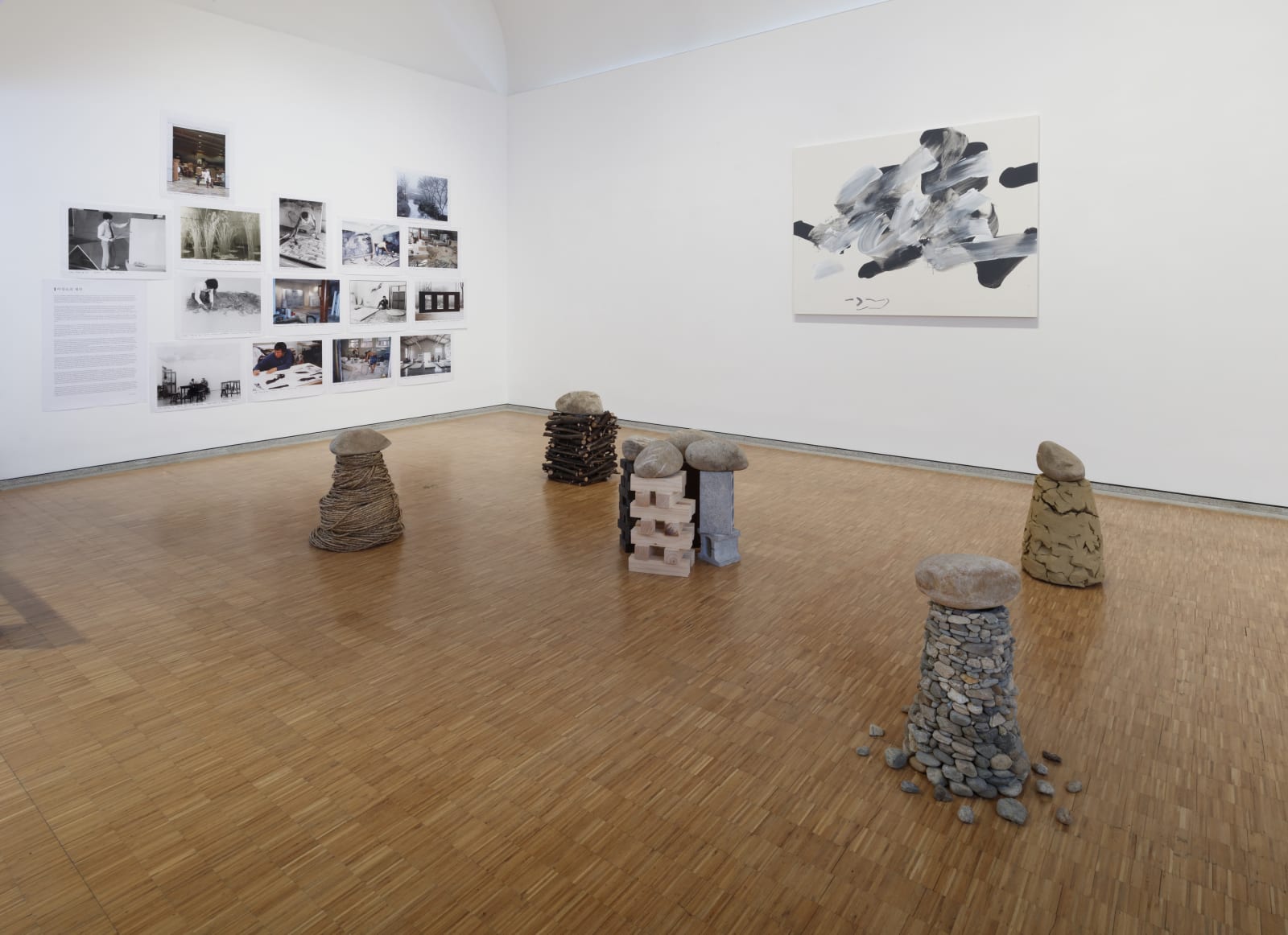

Lee Kang So
Overview
Whether in painting or sculpture, I wish for all works to form a structure where some pure energy in myself and that in the onlooker can mutually interact.
— Lee Kang So
Lee Kang So (b.1943, Daegu) is one of Korea’s foremost contemporary artists. Since the 1970s he has worked across photography, painting, printmaking, sculpture, installation and performance to develop a highly experimental practice that has profoundly shaped the evolution of Korean contemporary art. He began his career staging avant-garde performances and installations, and his international reputation was cemented at the 9th Paris Biennale in 1975 when he tethered a live chicken to a wooden feeder surrounded by powdered chalk. The traces of its white dusty footprints were conceived as a form of mark-making that transcended the autonomy of the artist to express the transience of our human presence in an ever-changing world. Such attentiveness to the distribution of creative energy between the artist and their materials underpins Lee Kang So’s subsequent interrogation of the very praxes of painting and sculpture, which continues to this day. Drawing upon traditional East Asian philosophical and aesthetic principles, he has developed an intuitive and embodied approach to artmaking. Liberated from set intent or meaning, his works are instead conceived as sites of creative participation between artist, object and audience.
Lee Kang So (b.1943, Daegu) is one of Korea’s foremost contemporary artists. Since the 1970s he has worked across photography, painting, printmaking, sculpture, installation and performance to develop a highly experimental practice that has profoundly shaped the evolution of Korean contemporary art. He began his career staging avant-garde performances and installations, and his international reputation was cemented at the 9th Paris Biennale in 1975 when he tethered a live chicken to a wooden feeder surrounded by powdered chalk. The traces of its white dusty footprints were conceived as a form of mark-making that transcended the autonomy of the artist to express the transience of our human presence in an ever-changing world. Such attentiveness to the distribution of creative energy between the artist and their materials underpins Lee Kang So’s subsequent interrogation of the very praxes of painting and sculpture, which continues to this day. Drawing upon traditional East Asian philosophical and aesthetic principles, he has developed an intuitive and embodied approach to artmaking. Liberated from set intent or meaning, his works are instead conceived as sites of creative participation between artist, object and audience.
‘Painting has always been my main interest,’ says Lee Kang So. ‘Endless cultivation and training conveys my spirit precisely in the interactions between body and brush, paint and canvas.’ Early experiments with painting were rooted in the artist’s interrogation of the canvas itself as he pulled at individual threads to create small openings and puckers in the rough hemp surfaces. Since the 1980s, he has directed his attention to the brushstroke. Fusing traditional and modern techniques, he works on canvas instead of rice paper and with paint instead of ink. Densely layered horizontal and vertical daubs of paint give way to the sparse articulations of birds, deer, boats, mountains and houses – their stylistic reduction a means to convey the vitality that runs through the world, rather than realistic representations of their forms. Elsewhere, expressive, pared-back monochromatic compositions of enlarged strokes evoke calligraphy and East Asian literati landscape traditions, while simultaneously gesturing to the aesthetics of Western minimalism. Favouring a long-handled East Asian ink brush for its ability to react more closely to the subtleties of his bodily movements, he works fast on wet ground to achieve a state of union between brush and hand, body and emotion.
Intuition guides Lee Kang So’s practice. Fundamentally driven by a deep sensitivity to his materials, he responds to their physical qualities to facilitate ‘coincidences’ rather than fixed, predetermined forms. Lumps of clay are thrown into the air and shaped by gravitational force, while ceramic sculptures find their form through processes of stacking and collapse. From 2010, the artist embarked on his ongoing series of Serenity paintings. In these works on canvas, the artist’s brushstrokes are directed by the rhythms of his own breathing patterns, bodily sensations and qi, or flow of vital energy, as it is conceived in East Asian philosophy. Across his present sculpture and painting practices, Lee Kang So elucidates the interconnections between the human and the non-human, material process and perceptual reception, artist and audience. ‘For me, canvas or paper are not simply objects or materials,’ he says. ‘They exist along with me as particles and waves at one time, laying out before me as an energy repeating creation and extinction at an unimaginable speed.’
Lee Kang So lives and works in Anseong (Gyeonggi Province, Korea). He graduated from the Painting Department of Seoul National University in 1965, subsequently participating in a number of avant-garde artistic initiatives in the following decades. In 1970 he was a founding member of the artist collective Shincheje (The New System), which stood in provocative opposition to the existing art circle dominant in Seoul. In 1974 he was instrumental in the founding of Daegu Contemporary Art Festival and championed the fostering of regional artistic practices outside of the country’s urban centres. From 1985 to 1986 he was a visiting artist at the State University of New York in Albany, NY whilst working as a professor at Gyeongsang National University, Jinju. He then participated in the MoMA PS1 Studio Artists Program from 1991–92. These international encounters speak to the wide reach of Lee Kang So’s work from the early decades of his career, as he formulated an idiosyncratic practice that developed alongside the legacies of other avant-garde movements, including Mono-ha in Japan, Korean Experimental Art, Minimalism in the United States and Arte Povera in Italy.
Lee Kang So has exhibited widely in Korea and beyond. The artist was the subject of a major solo exhibition at the National Museum of Modern and Contemporary Art, Seoul (2024), which continued at the Daegu Art Museum in September 2025. Between 2023 and 2024, his work was shown alongside that of his contemporaries in a major institutional touring exhibition, Only the Young: Experimental Art in Korea, 1960s–1970s, which travelled to the National Museum of Modern and Contemporary Art, Seoul; Solomon R. Guggenheim Museum, New York; and Hammer Museum, Los Angeles. In the five decades of his artistic career, the artist has shown work in countless other institutional exhibitions, including at the Daegu Art Museum (2021; 2020; 2018; 2011); Los Angeles County Museum of Art (2019); Musée d’art moderne et contemporain de Saint-Étienne Métropole (MAMC+) (2016); Tate Modern, London (2012–13); Musée des Arts Asiatiques, Nice (2006); Artsonje Museum, Gyeongju (2003); National Art Museum of China, Beijing (1995); Tate Liverpool (1992); Barbican, London (1992); Brooklyn Museum, New York (1981); Art Gallery of New South Wales, Sydney (1976); and Musée national d’art moderne, Paris (1975).
Lee Kang So is represented in important collections internationally, including that of Artsonje Museum, Gyeongju; Daegu Art Museum; Mie Prefectural Art Museum, Tsu; National Museum of Modern and Contemporary Art, Gwacheon; V&A Museum, London; and Written Art Foundation, Frankfurt, among others.
Historic works
Videos




















































































































































































































